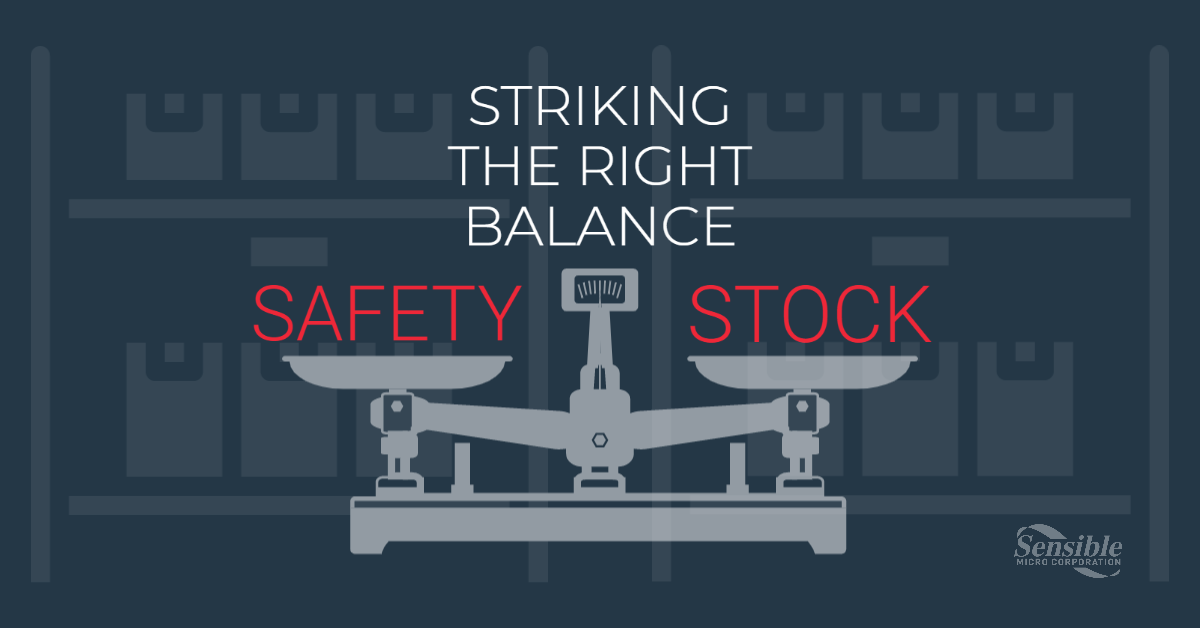Safety stock or “buffer stock” is a critical tool of efficient inventory management. In a highly competitive and heavily disrupted electronics supply chain, improvements in inventory have become a core focus for many companies.
The two sides of inventory — cycle stock and safety stock — work together to maximize your service level. Cycle stock fills orders in between replenishment deliveries. The purpose of safety stock is to provide a buffer between forecasted demand and actual demand (since no forecast is perfect). In other words, safety stock protects you against variability.
Setting the correct levels of safety stock is a tricky endeavor. Too little and stock-outs will hit you in spite of preventative efforts. Too much and you lose money carrying excess inventory with no demand.
Let’s examine how best to manage your safety stocking strategy.
The Importance of Safety Stock in Inventory Management
When used effectively, safety stock can minimize your inventory while still meeting variability in customer demand. And meeting demand variability is really important.
Stockouts — as a long-term pattern — will lead to reduced revenue, worse profit margins, lost customers, and regression in market share. It’s simple logic. Either meet the demand of your electronic component buyers, or they’ll find someone else who will. A reasonable stockpile of excess inventory gives you an emergency option when demand unexpectedly spikes well above your projections.
How to Calculate the Perfect Safety Stock Level
There are many ways to calculate safety stock, and no standardized formula can fully and accurately account for all of the unique variables that will impact your company. With that said, a widely accepted formula is a good place to start your calculations. The most common such formula in the supply chain looks like this:
Safety Stock = Service Factor (Z) × Standard Deviation of Lead Time Demand
As you can see, your safety stock level should essentially be a multiplication of your service level and the anticipated range of variations in both customer demand and lead times. If you were able to reduce variability to zero, you wouldn’t need safety stock at all.
Many companies in the electronics supply chain will make the mistake of using a textbook calculation without keeping other relevant factors in mind. For example, order quantity requirements and reorder periods might constrain your decisions. Upstream failure rates can also drastically swing lead times. When lead times and demand are not normally distributed (for one reason or another), the equation falls apart.
Stockpiling: A Good Idea...Until It Isn’t
The component shortages pressuring the electronic components supply chain have done real damage to companies that used just-in-time purchasing strategies. The reaction, naturally, was to pivot to stockpiling. We saw the same instinct take over the consumer mindset as they cleared shelves of toilet paper in early 2020.
There are two primary consequences of this response to supply chain disruptions:
- The “Bullwhip Effect"
- Excess Safety Stock
The bullwhip effect, according to CIPS, is when downstream demand fluctuations snowball into larger upstream fluctuations. Overbuying and stockpiling at the supplier level causes bigger overcorrections at the manufacturer and wholesaler levels. The resulting variance is much larger than that in sales to end customers. More variance creates more uncertainty and exaggerated demand fluctuations throughout the supply chain — and ultimately, too much excess safety stock at all levels.
Excess safety stock causes issues for cash flow, warehouse space shortages, ballooning operational costs, and other problems. These obstacles compound quickly if you’ve stockpiled too much and the safety stock lingers past its typical useful life in the supply chain. The solution is to move aggressively to address excess safety stock and vent it before it becomes a real drag on ROI.
Sensible Micro Can Help Manage Safety Stock Levels
Our vetted hybrid network of authorized and independent suppliers makes it fast and easy to liquidate excess safety stock, should the need arise, and keep your inventory levels at optimal efficiency for the variance you can reasonably anticipate.
We have the expertise and industry connections to efficiently move your excess electronic components inventory and get you in touch with a broad selection of qualified, interested buyers. An experienced supply chain partner is a critical ally as you assess your inventory needs.
Working with Sensible Micro on excess safety stock can mean significant savings, improved ROI, and faster movement vs. going it alone. Get in touch today.



















